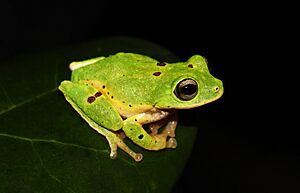Poppy's shrub frog facts for kids
Quick facts for kids Poppy's shrub frog |
|
|---|---|
 |
|
| Conservation status | |
| Scientific classification | |
| Synonyms | |
|
Philautus poppiae Meegaskumbura & Manamendra-Arachchi, 2005 |
The Pseudophilautus poppiae, also known as Poppy's shrub frog, is a type of frog. It belongs to the family Rhacophoridae. This frog lives only in Sri Lanka, which means it is endemic there. Its natural habitat is in wet, tropical montane forests. These are forests found on mountains. Scientists have found this frog living between 1060 and 1270 meters (about 3,478 to 4,167 feet) above sea level.
Contents
About Poppy's Shrub Frog
Poppy's shrub frog is a special creature. It is currently listed as critically endangered. This means it is at a very high risk of disappearing forever.
What Does It Look Like?
Adult male Poppy's shrub frogs are about 21.3 to 24.7 millimeters (0.8 to 1 inch) long. Adult female frogs are a bit larger, about 26.0 millimeters (1 inch) long.
The top and sides of the frog's head are a bright, glowing green color. Some of these frogs have red spots on their backs. Most, however, have black spots instead. The sides of their bodies are yellow. The middle of their body and the tops of their back legs are yellow-brown. Parts of their mouth are yellow or white. The tops of their front legs are yellow-green. There are white stripes along the outer edges of their front legs. The inner sides of their front legs are yellow. Their belly is also yellow.
Where Does It Live?
This frog is an arboreal animal. This means it lives strictly in trees. It makes its home in cloud forests. In these forests, the tree branches grow very close together. They form a thick, closed roof called a canopy.
Poppy's shrub frog lives on the lower branches of trees and in shrubs. Male frogs have been seen sitting on plants about 1 to 3 meters (3 to 10 feet) above the ground. This frog can also live in areas where cardamom plants are grown. These are areas with some plants but not a full forest.
How Does It Grow?
Like other frogs in the Pseudophilautus group, Poppy's shrub frog grows in a special way. It goes through something called direct development. This means that when the eggs hatch, a tiny froglet comes out. There is no free-swimming tadpole stage. The baby frog looks like a miniature adult right away!
Why Is It Called Poppy's Shrub Frog?
Scientists gave this frog its name to honor Poppy Valentina Meyer. Her parents helped support a big project called the Global Amphibian Assessment. This project helps study and protect amphibians around the world.
Why Is It in Danger?
Poppy's shrub frog is in danger mainly because it is losing its habitat. Its home is being destroyed. Scientists say that several things are causing this problem:
- Urbanization: More towns and cities are being built. This takes away the frog's forest home.
- Grazing: Animals like cows or goats eat plants in the forest. This can damage the frog's habitat.
- Logging: Trees are being cut down for wood. This removes the very trees and shrubs where the frog lives.


